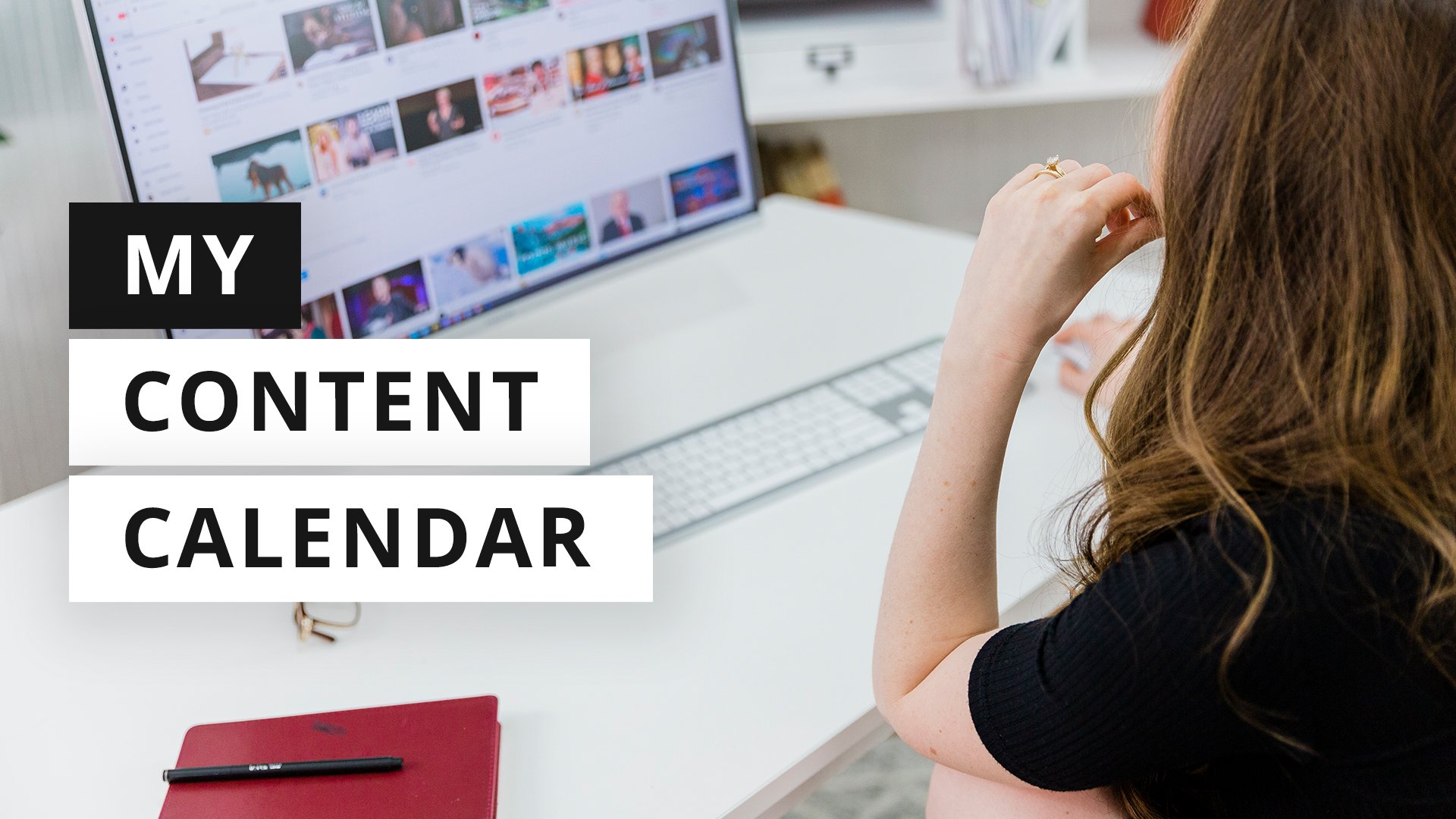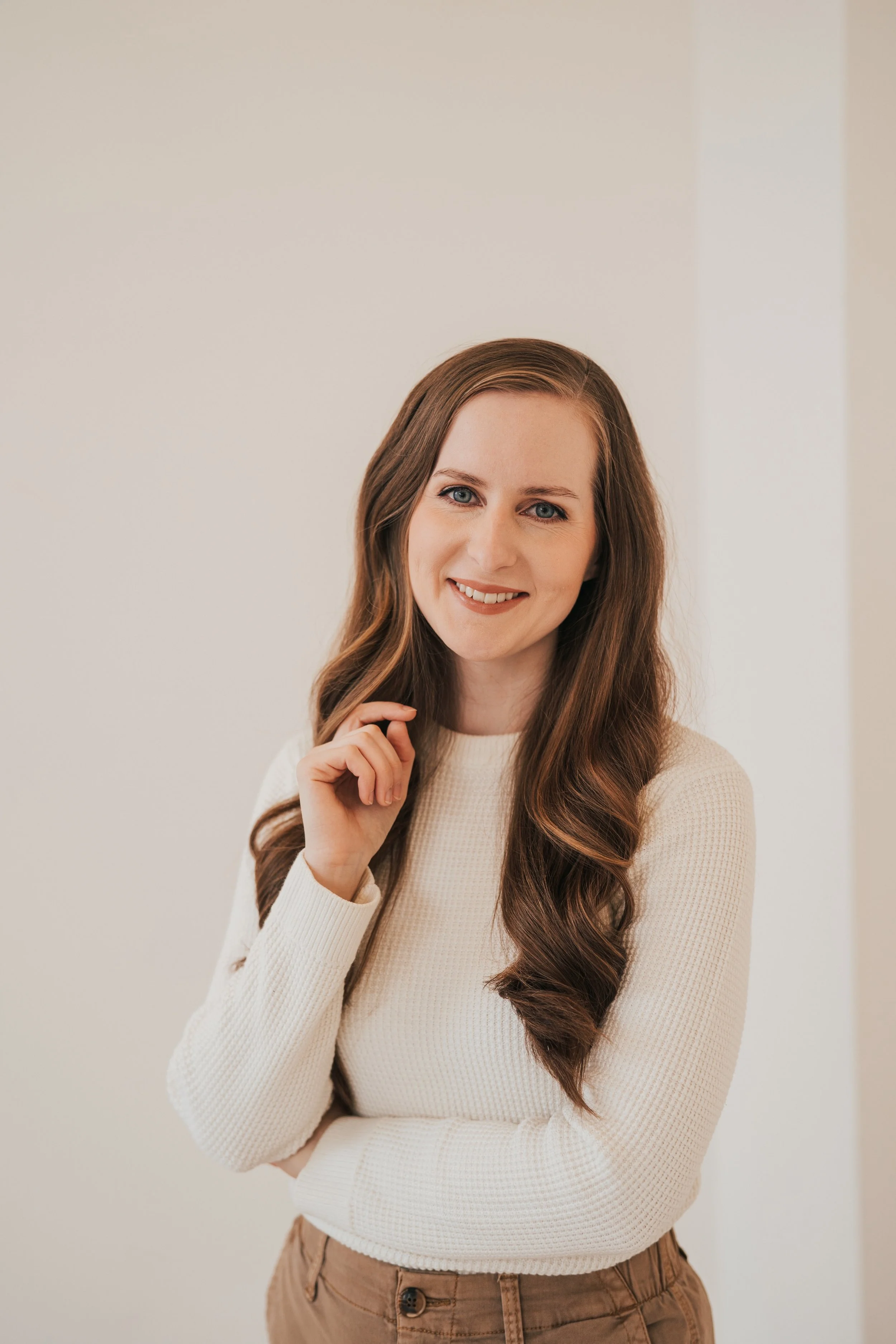How I Plan & Create My Content
Just like you, I have my favorite podcasters, YouTubers, and bloggers. I follow different experts, influencers, and brands on Instagram. And I'm subscribed to (more than) a few email newsletters.
Of course, I follow these people and consume their content because I'm interested in what they have to teach me.
But it's not just the topics they talk about that interest me… it's also about how they talk about those things.
See, as a content creator myself, I'm fascinated by the content creation process. How do they film their videos? How do they decide what to email their list about? Do they batch their Instagram posts or just create them on-the-fly? And HOW do they possibly manage to keep it all organized, strategic, and just… GET IT ALL DONE?
I want to know Every. Nerdy. Detail.
Why? Because I’m always looking for ways to create content in a more simple, efficient, and effective way.
So, what I want to do today (in case you’re a bit curious like I am about other online gurus) is to walk you through what my content creation process is like for each of these different pieces of content I publish.
Here's a breakdown of the different types of content I create each week:
YouTube videos
Podcast episodes
Email newsletters
Written articles
Instagram posts
However, before we dive into the details, I want you to know that my way isn’t necessarily what will be best for you, and I may not even recommend my process — especially if you’re new to creating content. This article simply explains what I actually do and is meant to give you an idea of the system I’ve found that works for me and how it’s evolved over the years.
If you’re just starting out, I recommend you check out the free Content Production Plan download I created for you as a simple outline for what your process could look like in the beginning.
There are so many moving pieces for these content creation processes, so I’m going to walk you through what I do monthly and weekly and then take you with me behind the scenes for an even closer look at how it all comes together.
What’s the difference between long-form and short-form content?
Long-form content is quite substantial and provides a good amount of value. It can be different types of content such as YouTube videos, podcast episodes, or written blog articles. This content typically is evergreen and something people could find if they did a search for the topic.
Short-form content, on the other hand, usually is more fleeting. Examples of this kind of content are social media posts. You may take a good chunk of time to create these posts, but they will not typically last for more than a day (sometimes minutes) in someone’s newsfeed.
Now that you know the two kinds of content, you could, perhaps, plan out every single piece of long- and short-form content you want to create every month.
I don’t do that.
I actually prefer to have some spontaneity in my creation process because I’ve found that it makes my content much more enjoyable, natural, and engaging with my audience.
Long-From Content Marketing Strategy
My long-form content is very planned out, and I have a strategy backing up those plans. I make sure to think about any launches coming up and formulate a plan for what type of topics to cover that complement those events to make them more successful when I begin promoting them.
Another thing I keep in consideration is any evergreen sales funnels I have running behind the scenes and what I can do to support them with my weekly content. I ask myself, “How can I attract people who are interested in buying these products?”
Short-Form Content Marketing Strategy (for Social Media)
This is where I’m a bit more spontaneous like I mentioned above. I create these types of posts more on-the-fly, but on a schedule (does that make sense?). I post on Instagram once per week, for example, because it isn’t a huge priority of mine.
What I post on Instagram could be related to a piece of long-form content I created recently or it may feature an upcoming event; but, most of the time, it’s where I showcase fun family updates or behind-the-scenes peeks in my business (if you want to see the messy, relatable side of things, then make sure to join me over on Insta!).
Monthly Long-Form Content Production Process
Now that you know the difference between long- and short-form content and my strategies for both, let’s dive into my monthly processes for creating long-form content.
Part 1 – Generate Content Ideas
I don’t just dive in and begin creating. Rather, my production process starts about two months before content is officially published. I actually take a step back and brainstorm different ideas for my long-form content. It’s a bit hard to plan content without ideas, so I’m constantly making lists when ANY idea comes to mind (even if it seems silly!).
I generate ideas almost every day, but once a month I sit down for a strategic planning session. In these sessions, I ask myself two different questions to get me thinking:
What ideas do I want to promote right now?
More specifically, are there upcoming launches that people will need to understand certain aspects ahead of time in order to be interested in these events?
Part 2 – Planning & Scheduling Monthly Content
I begin my planning process with my video creation. I decide which videos I want to create and add them to my master content calendar in Asana, my project management tool.
On a side note: I have a board specifically for YouTube video ideas in Asana that is organized by topic, and that’s where all my crazy brainstorming ideas live! When I sit down to plan, I go straight to this board to decide which topics I’m most interested in at the moment and which will cater to any upcoming promotions I have planned.
(If you want to know more about how I utilize Asana to organize my content planning, make sure to watch the video because I screen share my board and give you some additional tips!)
From there, I move onto my podcast planning. The reason I start with YouTube rather than my podcast is simply because YouTube’s algorithm is a bit more aggressive, and need to do additional keyword research and planning. I get to have a bit more fun with the podcast because it isn’t as rigid.
Some of my podcast episodes get repurposed from my video audio, but others are different altogether. I only repurpose what I believe will do well in audio form and with that specific audience. I also tend to do quite a few interviews on my podcast, and I do not do this on YouTube. I’d say about half of my videos are also used on my podcast, which saves me quite a bit of time and helps everything be more cohesive.
Content Creation Process for Content Marketing
Once I know what type of content I want to create for YouTube and my podcast, and I’ve scheduled it all on my master content calendar in Asana, then it’s time for me to assign out specific tasks to get these pieces of content recorded and published.
As I decide when to schedule these specific tasks for, my general rule of thumb is to plan any production tasks (such as planning and filming) for the first half of the month, so I can use the second half of the month for post-production tasks (such as editing).
By the end of the month, all videos are created and ready to go, and we schedule them to be published the following month. Working ahead a month keeps me from feeling stressed and behind.
I think better on paper, so I make sure I schedule a task to at least outline each video. I’m a visual person, and working on paper helps me organize my thoughts better. It’s a different process because it’s not as conversational as when I’m speaking, and it comes more naturally for me to know what to do next when writing it out. My videos end up much higher quality when I take the time to research the topic and write out a thorough outline.
The core of my content planning is done once I have the outlines ready for my YouTube videos and podcast episodes, but I do take a moment to think about any social media posts that I want to make sure get created. Specifically, if I want to make sure to tell my audience about any upcoming events, then I will plan out those posts and put them on my master content calendar as well.
Here’s my planning process, step-by-step:
I think about any upcoming events or launches.
I choose videos I’m excited about that have demand and that tie into any upcoming events.
I choose what podcast episodes I want to focus on – which will be repurposed from YouTube videos and which I need to create from scratch.
I add these pieces of content to my master content calendar in Asana.
I schedule out the tasks for each piece of content so I know what needs to get done and when.
Part 3 – YouTube Video Production Process
I do change how I do these things from time to time, but here’s what’s been working pretty well for me right now:
In the first half of the month, I will do any production tasks that are exclusively mine, such as the planning, outlining, and filming of my videos. I like to film at least two videos back to back because then I can get ready and do the filming set up less often. I film about two to four videos a month, so my goal is to sit and film twice.
HOT TIP! When filming, I also knock out my thumbnail pictures. This saves me time, and I know I’m dressed and ready for the camera. Many times I record a video clip where I make different hand gestures and expressions, and I’ll use a still shot from one of those to create my thumbnail.
Once I have all the filming knocked out, I make sure to upload the recordings to Google Drive so my team can take over the rest of the production in the second half of the month.
Part 4 – Podcast Production Process
This part is exciting! Because of the crossover between YouTube and my podcast, I already have about half of the podcast content done! I can just use the audio from the video I previously recorded.
For any additional audio content that I need to record, I’ll finish the planning processes and record them. The set up is simple because all I need is a microphone and a recording device, and my favorite right now is Riverside. I can record both solo and guest interview episodes inside the program, so this streamlines my processes.
My audio files are automatically delivered to the cloud after I record, so my podcast editors can take them from there and get them ready for publishing.
For my guest interviews, I plan these episodes alongside my other long-form content, and once I have the date scheduled for recording, my team will make sure all the other details up until the interview are taken care of.
What do my weekly content-creation tasks look like?
Every week I write an email newsletter, post on Instagram, and create a written article for my website.
Part 1 – Weekly Email Newsletter Production
Normally, I write my weekly email on Tuesdays and schedule it to release on Wednesday mornings. Many people encourage writing email newsletters ahead of time (or batching), but I’ve found I’m the most natural and organic when I write it just before sending. ConvertKit makes my email writing process super simple.
I’m going to be honest…
I don’t plan my email newsletters out extensively ahead of time. Here’s why: I like my tone to be more natural and conversational, and I find writing them more last minute helps me accomplish this goal. No one likes a robot!
My weekly email usually falls into one of two categories:
It relates to an upcoming launch or event (which is planned ahead of time)
It relates to content released that week (more on-the-fly writing). If this is the case, I just decide which of my long-form content I prefer to promote to my audience this week (my podcast or my YouTube video). Then I write an email letting them know about the content, why I created it, and what they will get out of it.
The most important thing to do in your email newsletter is to meet people where they are at and to give them value for the stage they are in.
Think about how they’ll consume the content you are giving them, and decide how you can provide value within that space. For instance, I prefer to put the content of my long-form video or podcast in the body of the email itself rather than just adding a link for them to go elsewhere to get the information I’m promising to them. I want to make it so they get a win right inside their inbox each week!
Part 2 – Instagram Posts Creation & Schedule
I’ll post randomly sometimes, but I do try to post at least once a week on Wednesdays to keep my account active and so new people following me have something to see.
To accomplish this, I actually post from my desktop computer, and here’s why:
It is way easier to type on my computer than on my phone.
I’m less likely to go down rabbit trails scrolling social media.
I have an Android phone, and Instagram works better on Apple.
It’s higher resolution when posting from the desktop than from an Android phone.
I schedule posts through Creator Studio, and it makes it easy to write my caption and add my picture. Then I can publish immediately or schedule out for later. Done!
Part 3 – Video Production Asana Workflow (AKA “kanban board”)
The next thing we do when it comes to content creation is move each video through the production process in the Asana project I’ve created to keep us organized and knowing which step each video is on at that particular moment.
The Asana project board has sections that include:
To plan
To film
To edit
Revisions
To schedule
Published
Promoted
What about PAID content?
If you subscribe to my YouTube channel, podcast, or newsletter, you get so much content for free! But all these pieces don’t include content I’m creating for current students in my paid courses or making yearly updates to any of my program offerings.
My paid content includes:
Video lessons
Written materials (worksheets for comprehension and execution)
Onboarding materials for students
Program-specific newsletters (weekly or monthly)
Creating content for student community groups
We are fitting these paid pieces of content in between making sure we are consistently publishing our free content for you so you can grow a successful YouTube channel and online business!
So, there you have it!
A peek behind the scenes of my content creation process. I know it looks like I have it made because I also have a team helping me, but I want you to know that only a few years back, I created nearly just as much content without any help.
Every week I created two YouTube videos, sent a newsletter, and posted on Instagram (and I was still only working around 20 hours a week). I tell you this to let you know that you don’t need a team in order to create a substantial amount of content.
Now I’ve chosen to scale back to one video a week on YouTube, but I’ve also added recording a weekly podcast and publishing regular articles on my website. I couldn’t do all these things without my team now, that’s for sure (at least if I want to keep my hours to 20 a week)!
My team helps me with the following tasks when it comes to production:
Video editing
Podcast editing
Graphic design
Publishing content
Again, remember, I wanted to share with you how I create my content (and it is a messy, complicated process sometimes), but I don’t always recommend you do it exactly like I do!
Take what you can from this article and create a production schedule that will work for you in the stage of business you are in. Feel free to download the free content production plan that I created with you in mind! This will simplify the process of content creation as you get started.
free content production guide
Want to start creating content, but need some help? I've got plenty to share with you!
Download the resource for free, and find the schedule for your skills and goals.








